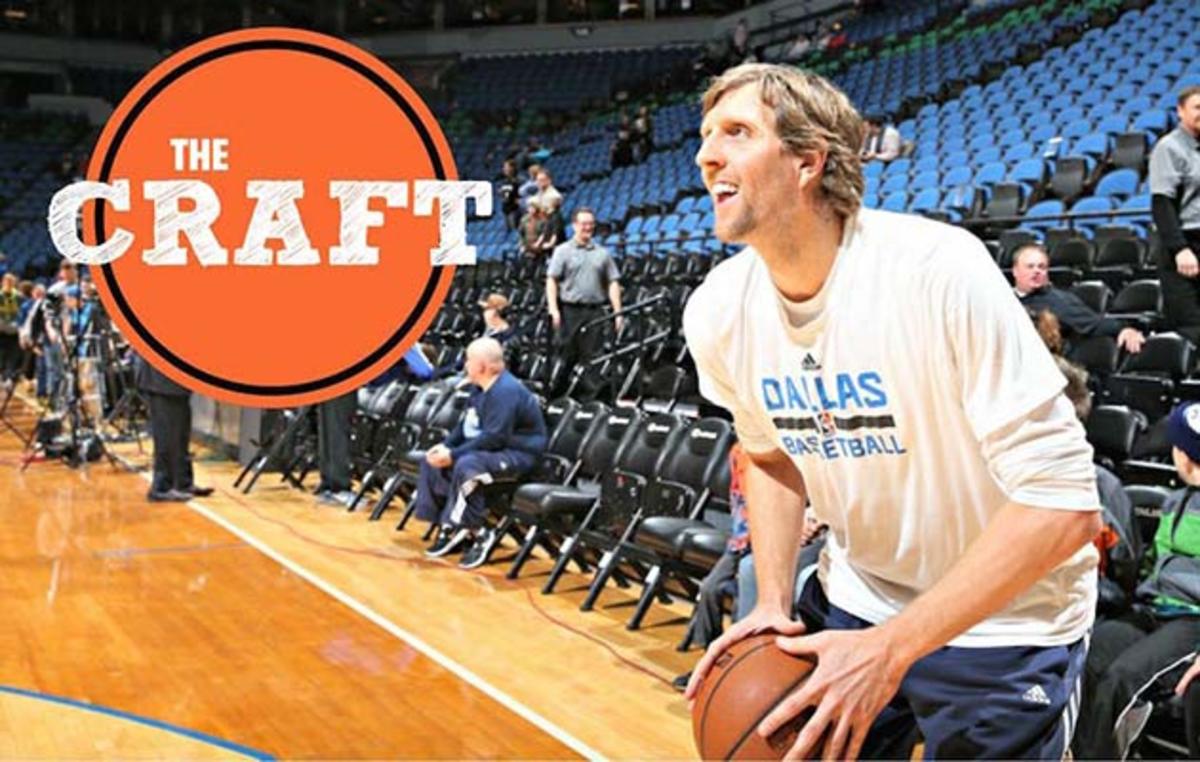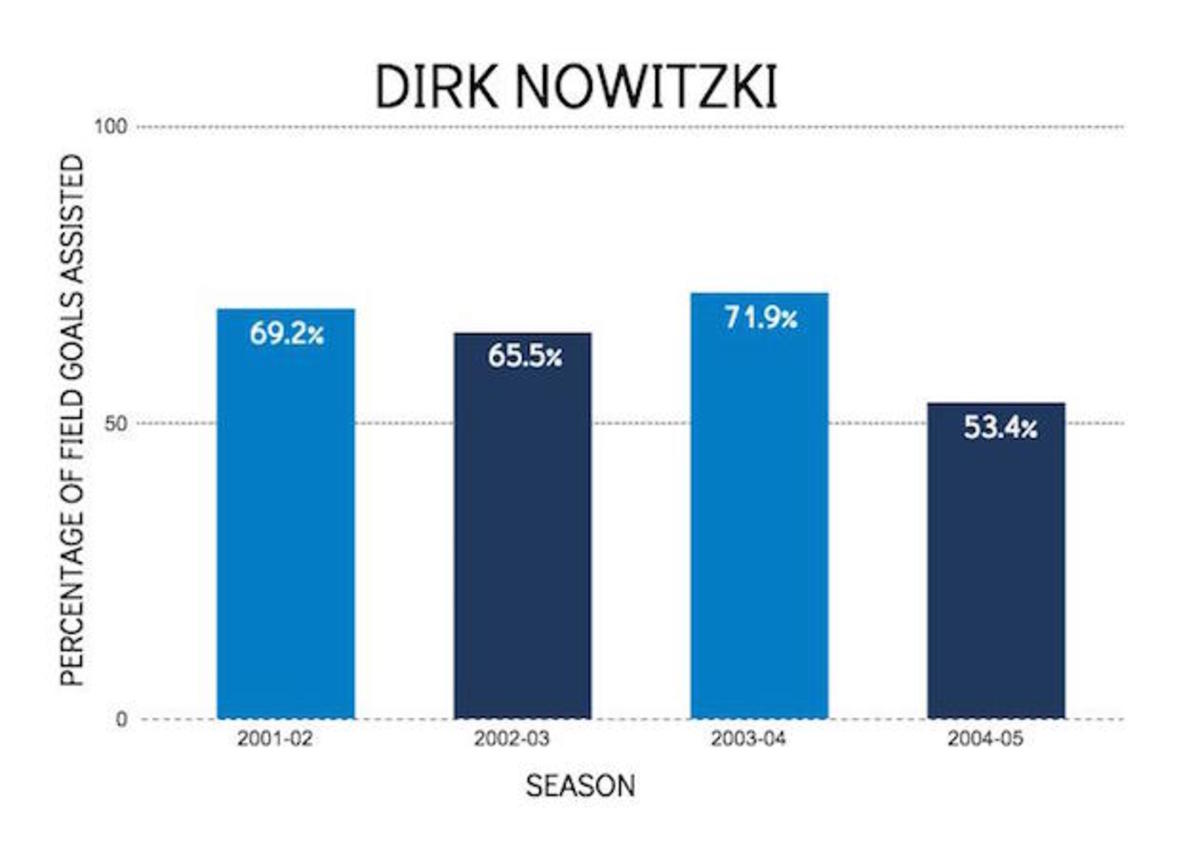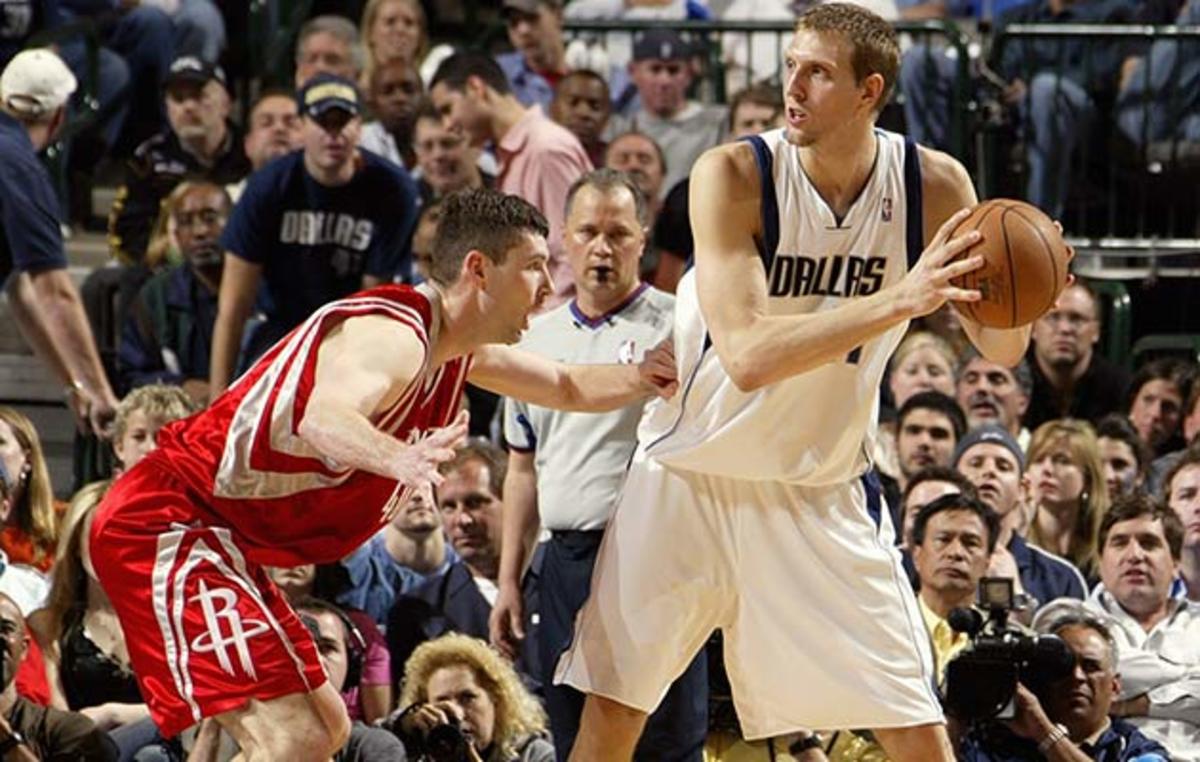The Craft: The genius of Dirk Nowitzki

Welcome to The Craft, aseriallookinside the world of player development in the NBA.
DALLAS — Some assistant coach, scout, or video coordinator is staring at a screen at this very moment, racking their brain behind bleary eyes. The predicament they face is the same one that NBA strategists have pondered for almost two decades: How can a defense contain Dirk Nowitzki without abandoning everything else?
The premise has cost team personnel around the league untold hours of sleep and caused others to scream themselves hoarse. It's occupied thousands of pages in scouting reports and borne desperate, scribbled reminders on whiteboards in every NBA locker room. Most have come to approach the task with a sort of shrugging resignation; you match up against Dirk in your preferred style, tweak your pick-and-roll coverage out of respect for his shooting, and hope for the best. Sometimes that's enough. More often, even with Nowitzki now in his 18th season, it isn't.
Widespread acceptance of that fact is the product of Nowitzki's relentless adaptation. His career has been a march of progress in the face of evolving coverage, with every defensive strategy aimed at Nowitzki bringing out some new wrinkle in his game. Even those devices that slowed Nowitzki over the course of a playoff series were neutralized with thoughtful off-season address.
“Every year we see new things, whether it’s his fadeaways or his drives or his spins, his pump fakes," Gregg Popovich said of Nowitzki in 2014. "Every year he got better in some aspect of the game and worked himself into position offensively where he was impossible to guard."
The origin of that impossibility lies in a flawed and underwhelming rookie season. The young Nowitzki was a shooter and little else. He didn't have the strength to hold his position on the block or the footwork to play the angles. Any possession that required more than a catch and release had the potential to turn into a bumbling mess.
"I was lost," Nowitzki told SI.com. The haste of the league in scraping together a post-lockout season only made matters worse for a 20-year-old international rookie in over his head. Nowitzki remembers hoping that the first year of his career would be canceled so he could prepare fully in Germany. Instead, the season was saved and his game put to the test. The talent and the touch were there. The overall skill set was not.

Had Nowitzki played under any coach but Don Nelson, his initial struggles—and very real doubts about his own NBA future—might have altered the course of his career. But Nelson believed in him wholeheartedly, and as soon as Dallas's season took a turn, he returned Nowitzki to the starting lineup on a full-time basis. Those final 14 games of the season gave Dirk good reason to believe in himself as an NBA player and a clear track toward the next stage in his development.
"I think it was pretty obvious in the beginning that I was just a good shooter," Nowitzki said. "I was seven feet but I was a spot-up shooter. Guys would try to run me off the three, so my first priority was an off-the-dribble move. You've got to have a little in-between game if you want to get better."
Cowboy Way: Dirk still loving the ride
This became the basic format of Nowitzki's basketball advancement. Take what you do well and hone it to the point that opponents have no choice but to adjust. Then, after forcing the defense's hand, build an easily accessible counter that renders their adjustment irrelevant. A hard close-out begets a mid-range jumper off of one or two dribbles. Make that shot consistently enough and the defense bends again—this time putting itself in an even more vulnerable position. Nowitzki rarely took pause in those early years, transitioning from regular season play into his work with mentor/shooting coach/basketball sage Holger Geschwindner to time with the national team and a stint in summer league. There was always a venue to act as a vehicle for his improvement, even if it was merely an empty gym under Geschwindner's watch.
Everything for Nowitzki came in stages. The pick-and-roll-heavy style Dallas employed didn't require him to be overwhelming in the post, only opportunistic. Dirk's early targets were largely point guards who tried to pacify the Mavericks' two-man game by switching to him off of Steve Nash.
"More guys started switching my pick-and-roll and I'd have nothing," Nowitzki said."I had to add a little more [in the post], even though it wasn't quite comfortable for me. I had always played facing the basket my entire career. I had to get used to it."
Dallas didn't have a proper practice facility back then, so Nowitzki and Nash would sometimes spend their nights shooting around at a local health club. On the main court was the gym's regular run, filled with nine-to-fivers getting in a workout. Off to the side were two future Hall-of-Famers, practicing post-ups and baseline jumpers on a side hoop and trying their best to stay out of the way. The one-on-one games between Nash and Nowitzki have become a part of the lore of their friendship. The benefits for Nowitzki, however, were made tangible more immediately in the ways he learned to use his height to his advantage against smaller defenders.
The game opened up for Nowitzki once it became clear that defenders needed to be so tall to even take the ride. Traditional bigs, deprived of a switching exit strategy, were eventually left helpless in the Nash-Nowitzki pick-and-roll. Nash was quick to turn the corner and apply pressure. It's easy to forget how explosive Dirk was back then, too. Opponents who played his jumper too closely not only risked the mid-range game he had worked to cultivate, but hard drives that would beat the rotation of the defense to the rim.
Nowitzki's game again took a turn when circumstances next demanded it. Nash left the Mavericks in 2004 to find a bigger contract and basketball actualization with Phoenix. He took with him the primary engine for Nowitzki's offense. As a matter of necessity, Dirk's game immediately began to change shape.

Data courtesy of NBA.com.
Dallas couldn't rely on Jason Terry in the same way as his predecessor, making the idea of the Mavericks as "Dirk's team" more than a sportswriter's conceit. It was then that isolation play became a real, operative piece of Nowitzki's repertoire. Some sequences began on the wing and others at the elbow. Regardless of origin, it was necessary for Nowitzki to create one-on-one offense in a volume he never had previously. He responded with the most productive season of his career.
Then came the Rockets.
Jeff Van Gundy had coached Houston to top-five defensive standing in the 2004-05 season but had no natural foil for Nowitzki in their prospective first-round series. Clarence Weatherspoon, who had been the starting power forward, could barely tiptoe into Nowitzki's line of sight. Van Gundy opted instead to have his lankiest wings guard Dirk in a deliberate mismatch. Ryan Bowen (and later Tracy McGrady) did everything he could to disrupt the balance and timing of Nowitzki's face-up game while Yao Ming lurked in the paint.
"They didn't let me sit there and watch and face up, giving me time," Nowitzki said. "[Houston] had a smaller guy basically trying to keep me uncomfortable. They were always stabbing [at the ball] or getting under me. That was new."
Not only was it new—it was shockingly effective. Nowitzki made just 13 of 40 shots while the Mavericks dropped the first two games of the series at home. In that particular moment in time, Bowen was actually discussed as a nullifier of Nowitzki's face-up game. Bowen himself dismissed the notion quickly but the absurdity of that line of commentary is not lost on Dirk.
"They called Ryan 'The Germanator' that series," Nowitzki said with a smile.

Nowitzki found his bearings against Bowen in Game 3 and had played him out of the starting lineup by Game 4. McGrady, however, had continued success pressuring Nowitzki by invading his personal space. The Dirk of those days wasn't a particularly experienced back-to-the-basket player, which made it all the more difficult to shield the ball from McGrady while still working toward an efficient shot. Houston took advantage to what extent it could, though Nowitzki found ways to chip in points and set up his teammates while influencing plays with his very presence. Dallas, once down 0-2 on its home floor, won in seven games.
"Other than Shaq," Van Gundy said at the time, per ESPN.com, "I don't know if there's one player [in the league] who distorts your defense like [Nowitzki] does."
The need to develop an effective workaround was made clear by Nowitzki's experiences in that series, as well as the Mavs' loss in the following round against Phoenix.
"I think the toughest guys were the Shawn Marion body type," Nowitzki said. "Guys that are 6'8" or 6'9", strong enough to keep me a little bit out of the post so I can't just back them in under the hoop but long enough when I shoot my turnaround that they're still right there. Those skinnier guys that are faster than me but still long enough to contest my shots—those guys gave me the most problems."
The means to control those matchups came through two crucial developments to Nowitzki's game. The first was a focus on establishing Dirk in the low post, which became a priority in Avery Johnson's first full season as head coach in Dallas. With more repetition, Nowitzki came to love it.
The second was a post-up alternative introduced for the sake of time and access. Terry was no Nash, but by year two he had developed a smooth pick-and-roll chemistry with Dirk predicated on their shared mid-range proficiency. Once teams began to switch on that sequence to cover for Terry's pull-up jumper, Johnson had Nowitzki punish mismatched defenders by isolating them at the top of the floor.
"A lot of teams started to switch and by the time you roll down to the block, they fight you and fight you," Nowitzki said. "You lose a couple seconds there. Then some teams—well, most teams do it now—by the time you roll them down, they back-switch so the other big guy from the baseline comes over. The little guy just runs over to the weak side and you've got nothing. You've got another big guy in front of you. The thinking was since my game is not really pound and pound and get to a jump hook anyways—my game is like one or two dribbles and then shoot over them—that you can do the same thing from the free throw line. Just act like this is the block and just try to punish the little guy."
Dirk Nowitzki outtakes: Mavs star on life, hoops and Hasselhoff
The Mavericks called the setup "ear." With it in his back pocket, Nowitzki elevated under-equipped Mavericks teams to the Finals in 2006 and 67 regular–season wins in 2007 while inching his game inward from the three-point line. The devastating ends to both of those seasons are well understood as narrative points in Nowitzki's journey. Developmentally speaking, they were just as important; Nowitzki's performance against the Heat in 2006 isolated a need to better deal with fronting defenders in the post (with looming back-side help) while the now infamous first-round defeat in 2007 highlighted an exploitable flaw in Nowitzki's shot creation.
Nelson, then as coach of the Warriors, armed Golden State with both a smart matchup strategy and detailed knowledge of Nowitzki's post game. It began with the 6'8" Stephen Jackson reprising the role of McGrady—a long, agile defender whose chief responsibility was to keep Dirk off-balance. In support, the Warriors prepared a second defender to dart toward Nowitzki in the brief, blind window left open on his spin.
"My move became to go one way, and when you cut me off with a smaller guy, I'd spin back and it's too late. I'm gone—either at the rim or leaning back. Once I dribbled one way, [the Warriors] started coming from the back side and once I spun, I didn't see them or what was coming and the ball was gone. That was a good technique to kind of stop me because once I put it down on the floor, I had to worry about my spin-back for the guy to be there. That was smart."
Nowitzki was visibly rattled. The style Golden State employed had Dirk scanning the floor when he should have made decisive moves and rushing through plays when it would have been wiser to take his time. There was an uncharacteristic panic to his game that fed into the atmosphere of the series; turnovers created Warriors fast breaks which fed into a smothering momentum. Without their centered, fully effective superstar, the Mavericks floundered.
Nowitzki had been a six-time All-Star, an All-NBA fixture, and a worthy MVP to that point. But it was only after the loss to Golden State that his game found its true sophistication—that combination of poise, approach, and ability that would key Dallas's eventual title run. Learning from his mistakes in that matchup helped to unlock a more complete view of the game and how to maneuver within it.
"I think as you get older, the game slows down," Nowitzki said. "You see things better. If they play you like [the Warriors did], you take them down on the block, go one way and you know they're coming [on the double]. You take up the ball and swing it, maybe get somebody else a shot on the weak side. Being more experienced, taking your time, and if that double team or triple team does come, get a better pass. When I first got on the block more and more, I saw more double teams. I was really rattled at the beginning. I still wouldn't say I'm a good passer, but I'm decent enough to make guys pay if they double team me with smaller guys."
On a procedural level, Nowitzki even experimented with eliminating the spin from his game altogether. He toyed with a behind-the-back dribble and a few other alternatives that would have kept his vision of the court clear, but the change didn't take. "I never got ahead of that curve," Nowitzki said. "The spin was just so automatic to me. I've been doing it my entire career."
Regardless, the teams that tried to emulate the Warriors' style of defense encountered a more aware Nowitzki, ready to make both the easy pass out of pressure and the cross-court feed when the moment allowed. It speaks to the quandary of defending Nowitzki today that some coaches still prescribe those aggressive strategies in spite of his growth as a passer. Bucks coach and former teammate Jason Kidd, Dirk noted, opts to guard Nowitzki with a smaller defender and "bum rush" him as soon as he gets to the block.
That can cause a turnover or two, though on balance it rarely works out to an opponent's benefit. The search for an effective counterplan continues—no matter that Nowitzki's best basketball is behind him. Few individual performances are more impressive than Dirk's undeniable run through the 2011 playoffs. That was an alltime great in full command, the game itself at his mercy.
The Dirk of today is a quieter variety, if not so much literally. His voice still booms through the American Airlines Center as he jeers his teammates or preemptively announces his victory in a post-practice shooting game. Maturity and levity are by no means exclusive, and Nowitzki will forever be in on the gag.
• MORE NBA: Rare photos of Dirk Nowitzki over the years
His game, though, is mindfully conservative. Rick Carlisle goes to great lengths to make his offense as diverse as possible by leveraging the problems Nowitzki presents without the ball. Force-feeding Dirk on the block or in isolation would exhaust his on-court value without the same margin to show for it. Positioning him as a screener, spacer, and decoy, however, allows Dallas to power its offense with crucial misdirection. Few in the game have a more nuanced understanding of what makes a defense tick than Carlisle. That knowledge is put into practice now as a means of sustenance.
Many of the wrinkles in Nowitzki's game work to a similar end. Development in the moment came in service of maximization; every added move was intended to make a great player greater. Yet now that Nowitzki is nearing the end of his career, we find that many of those same building blocks have doubled as tools of extension. Take, for example, his signature one-legged fade.
"As you get older, when they're up close you can't always put your head down and drive and drive. It's a wear and tear over a long season. That's actually a shot that I've developed that's energy-sufficient and I'm still able to get a little separation and have a good look at the basket. I'm just always trying to find something that works."
Remarkably, he always has. Nowitzki witnessed the bounds of the league's creativity and the great lengths of its athleticism. Still he's come out ahead at every turn by boldly and doggedly pushing his game forward. What brought Dirk first to stardom now ushers him, gracefully, into his career's twilight. The work endures.
